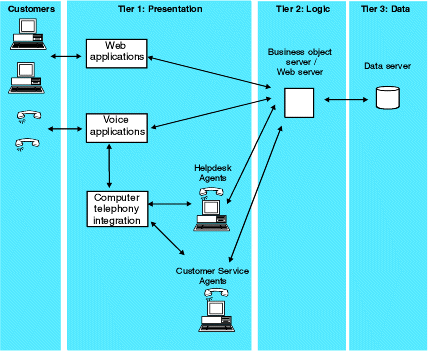- Some people will want to buy only the new release. They'll want to find out where the nearest supplier is, download the software from the Web, and so on.
- Some people, who have already installed the new release, will be looking for technical advice or help.
- Some people might have bought the previous release just the week before, and will want a cheap (preferably free) upgrade to the new release.
Preparing for the expected
The Software Company's main challenge is to handle peaks in customer demand, without setting up a complicated and expensive customer contact system that is often idle outside those peak periods. It also needs to address the problem that the peak periods include several different kinds of customer queries.
The company can deal with the problems piece by piece, by automatically filtering the demand. Figure 1 shows how everything fits together.

- The ability to order, or download, new releases of software over the Web
- The ability to upgrade existing software over the Web
- A frequently asked questions (FAQ) page to answer common questions about new releases
Sometimes customers will not or cannot use the Web for their query. Before moving directly to a human agent at this point, The Software Company uses voice applications to filter calls.
- Providing a similar set of services to those provided over the Web filters out a percentage of the total demand on the company's agents.
- The Software Company can use voice applications to provide a 24–hour, 7–day service. Business is no longer lost, therefore, when people try to contact the company outside normal business hours.
- When a customer elects from the voice applications to be transferred
to an agent, it gives the company the chance to further filter calls
by establishing the type of call before automatically forwarding it
to the agent.
For example, The Software Company can set up a menu that says: “To order BookCook Version 2, press 1; for technical help with installing BookCook 2, press 2; to report a problem with any version of BookCook, press 3....” and so on.
Using the intelligent call transfer functions that are available in computer-telephony integration (CTI) products (such as those from Genesys or Cisco), callers who want to order software can be connected to customer service agents; callers who want help with installation, or who have a problem, can be connected to helpdesk agents.
The combination of Web and voice applications minimizes the intervention of human agents, thereby cutting costs and providing an ‘out-of-hours' service.